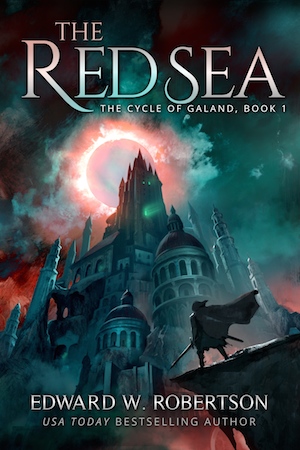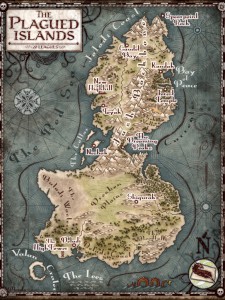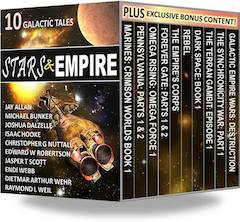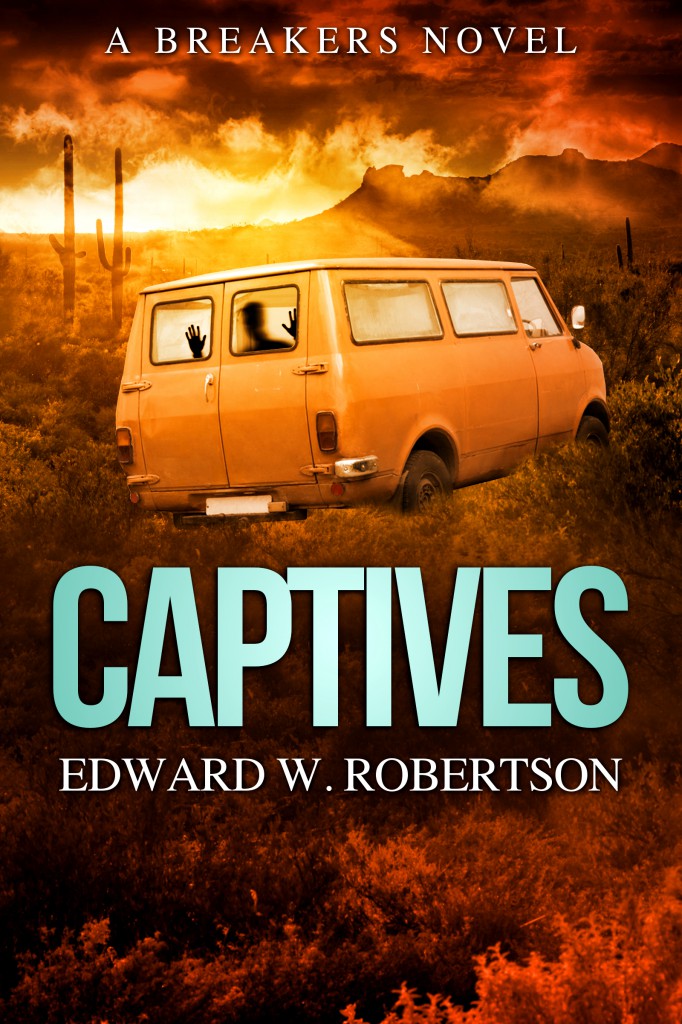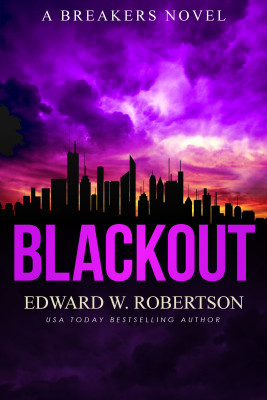After delays of every conceivable kind—I’m surprised the manuscript wasn’t at one point captured by pirates and held for ransom—I’m very, very happy to announce that WHAT LIES BEYOND: The Cycle of Galand #6 is now live.
You can get the ebook on Amazon.
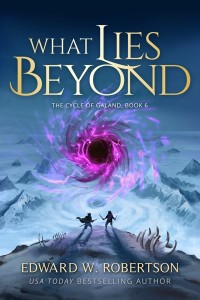 The paperback should be ready in another day or two. One of the nice things about it taking so long to publish this is that my publishers will be able to get the audiobook out more quickly than normal. In fact, Tim’s going to start recording it next month. I don’t know yet exactly when it’ll be out, but I think there’s an outside shot it’ll be live before year’s end, though early next year is more likely.
The paperback should be ready in another day or two. One of the nice things about it taking so long to publish this is that my publishers will be able to get the audiobook out more quickly than normal. In fact, Tim’s going to start recording it next month. I don’t know yet exactly when it’ll be out, but I think there’s an outside shot it’ll be live before year’s end, though early next year is more likely.
We’re nearing the end of the series, but there’ll be at least one more book left after this one, and quite possibly two. I’ll have at least one of ’em out next year.
Next on the docket: the sequel to THE SEALED CITADEL, the first Cally book, which I’m planning to have out in December. What do you mean you haven’t read the first book yet?? Fix that right now! Don’t you know the audiobook will be out on November 5? And that Tim Gerard Reynolds is narrating? As young Cally? What could be better? That’s not rhetorical, I really can’t think of anything better than that.
Except, perhaps, wrapping this up and going off to play Stardew Valley, because it was supposed to be my day off. Those digital strawberries won’t pick themselves!
In the meantime, hope you guys enjoy this one. And that it’s long enough to keep you occupied for at least a few days.
Today marks a bold new day in Cycle of Galand #4 releasing: THE LIGHT OF LIFE, The Cycle of Galand #4, has now been released. You can find it on Amazon, Amazon UK, and paperback.
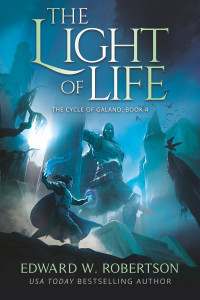 For audiobook listeners, the wait will be shorter this time. THE LIGHT OF LIFE is tentatively scheduled for an August 15 audiobook release. Note this date isn’t chiseled in stone until the preorder’s up, but that’s the plan as it stands. As always, the inestimable Tim Gerard Reynolds will provide narration.
For audiobook listeners, the wait will be shorter this time. THE LIGHT OF LIFE is tentatively scheduled for an August 15 audiobook release. Note this date isn’t chiseled in stone until the preorder’s up, but that’s the plan as it stands. As always, the inestimable Tim Gerard Reynolds will provide narration.
Oh, and if you’re new to the series, you can start with THE RED SEA, The Cycle of Galand #1. Or start at the very beginning with THE CYCLE OF ARAWN, the complete epic fantasy trilogy, which retails for a lowly $4.99, or is free to read through Kindle Unlimited.
I’ll have some updates on future projects, including further books in this series, in a couple of weeks. For now, go read and be merry, for Elon Musk hasn’t yet invented books that can read themselves.
I am excited, stoked, and chuffed to announce that Dante and Blays are back in the saddle! THE WOUND OF THE WORLD: The Cycle of Galand #3 is now live. You can find it on Amazon and Amazon UK.
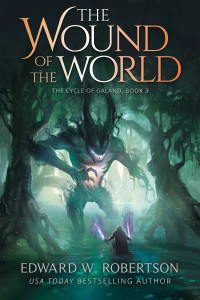 If you’re not a Kindle user, the Kindle app should work on most devices. If you can’t or won’t use Amazon, please email me at edwrobertson AT gmail and we’ll work something out. If you’re a paperback reader, I hope to have that version out within a week or two.
If you’re not a Kindle user, the Kindle app should work on most devices. If you can’t or won’t use Amazon, please email me at edwrobertson AT gmail and we’ll work something out. If you’re a paperback reader, I hope to have that version out within a week or two.
By the way, I get the impression a lot of people think this series will be a trilogy. Well how does it feel to be WRONG? Does it feel great? It should, because this series will actually be five or six books long. My intent is to start writing #4 by December (I have something else to wrap up first) and publish it by April 2017.
When will the audiobook for THE WOUND OF THE WORLD come out, you ask? Well, I’ve just sent the manuscript off to Podium, the audiobook publisher for this series. Tim Gerard Reynolds is slated to record it next month. After that, it’ll take some time for post-production, and a couple-three weeks to be submitted to and approved by Audible.
This is a long-winded way of saying it won’t be overnight. That said, it should be out early next year, perhaps even January. I know Podium will be eager to get rollin’ with it. Speaking of all these things! The Voice Arts Awards have nominated Tim and THE RED SEA for 2016 Best Narrator in a Fantasy novel. Winners will be announced November 13. *glares at VAAs* I’m sure the VAAs will make the correct decision.
Getting back to THE WOUND OF THE WORLD, I always feel a certain amount of trepidation publishing a new book—what if I’ve suddenly turned into a pumpkin and can’t be trusted to write a manual for a coffee machine, let alone a worthy sequel to my previous books??—but I am, at the moment, feeling pretty good about this one. It expands the world while leading to a story that I think will be pretty epic.
Enough blathering by me, either you’re going to buy it or you’re not. My recommendation: get it.
Yep. Got a new book out. Here’s the deal:
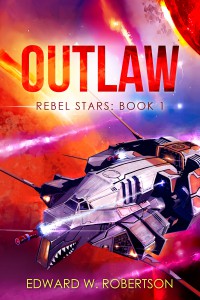 IN THE YEAR 2010, an alien virus nearly wiped out the human race. A thousand years later, mankind has recovered and ventured into space. There has been no sign of the aliens since. Humanity remains confined to the Solar System.
IN THE YEAR 2010, an alien virus nearly wiped out the human race. A thousand years later, mankind has recovered and ventured into space. There has been no sign of the aliens since. Humanity remains confined to the Solar System.
All that is about to change.
Mazzy Webber is a lowly janitor on a third-rate cargo ship. Deeply in debt, when his captain decides to turn pirate, he leaps at the chance.
A modern Robin Hood—minus the part where he gives back to the poor—Webber lays down a few ground rules. No attacking manned ships, and no stealing from anyone who can’t afford it. Within months, he and the crew are out of debt. Their next target will make them rich.
But the attack goes all wrong. The target’s cargo could be the death of them—or it could be the key to reaching the stars.
AVAILABLE HERE at $0.99:
Amazon | BN Nook | Apple | Kobo | Google Play
By the way, if that description sounds familiar…it should. OUTLAW is the first book in a new series set in the far future of the Breakers universe. While you absolutely don’t have to read the Breakers books to follow along, having that as background should add an extra layer to the fun.
It definitely made it more fun to write. I love space opera and have been wanting to start a new series for a long time. Putting it in the future of my particular world has given it its own unique history and flavor.
On top of that, looking at this as a publisher, this gives readers more to check out. Like the Rebel Stars stuff? Good news! Its apocalyptic history has already been chronicled in the Breakers series. Like Breakers? Well, clear up some space on your ereader! Because here’s what happens long after humanity bounces back.
I really can’t say how much crossover there will be. I can say that combining these series into the same universe pleases the heck out of me as both a writer and as a publisher.
I now have delusions of chronicling the complete history of this world. That might be too ambitious — or possibly too boring! — but it’s an exciting possibility.
That can wait for a later date. For now? Buy buy buy! Buy like the wind! A thousand years of silly fictional history depends on you.
Yesterday, Amazon touched off something of a firestorm by emailing hordes of readers and KDP authors for help, requesting authors email Hachette CEO Michael Pietsch to explain why lower prices are better for readers and the publishing industry.
Today, Pietsch has been responding to everyone who’s emailed him. I find his response reasonable enough — for the most part, he claims, Hachette’s ebooks fall beneath Amazon’s preferred $9.99 cap — but there’s one part that stuck out to me.
“The invention of mass-market paperbacks was great for all because it was not intended to replace hardbacks but to create a new format available later, at a lower price.”
This is false.
Well, technically, it isn’t false — it’s true that mass market paperbacks weren’t invented to replace hardbacks. But they weren’t published in the modern fashion, with a publisher releasing them months after the more expensive hardback. Rather, paperback rights were purchased by competing publishers who were able to sell their paperbacks for 10% of the price of the original hardcovers.
In other words, they were invented to disrupt the hardcover industry.
In 1939, the average hardcover cost $2.50-3.00 — the modern equivalent of $40-50. The new paperbacks cost $0.25 — a little over $4.00. Presumably, the first paperbacks were reprints in order to ensure the audience for those titles was already in place and minimize the paperback house’s risk of printing a dud. However, paperbacks blew up the market so well that by 1950, publishing houses were publishing paperback originals. It was feared these paperback originals would “undermine the whole structure of publishing.”
And they might have.
For more than twenty years, paperback prices held steady. They even declined; in 1961, some paperbacks cost as little as $0.35, just $2.79 in modern dollars. Then a funny thing happened. Starting around 1966, costs climbed to an adjusted $4-5. By 1975, they hit $6-7. And by the mid-1980s, mass market paperbacks cost the equivalent of $7-9.50. They’ve hung around $7.99-9.99 ever since.
After 25 years of steady prices, what happened to cause paperback prices to triple over the next twenty years?
When I first did this research two years ago, I stumbled onto the fact that this timeline coincided precisely with the conglomeration of the publishing industry. Beginning around 1958 and accelerating in the ’60s, small and medium publishers were gobbled up by the majors, culminating in today’s environment of the Big 5 (formerly 6). I assumed that the decrease in competition allowed the major houses to increase prices.
However, I think that’s only part of the puzzle. I am now entering the realm of speculation, so take the following with grains of salt. But I believe two more factors are at play.
First, most of the independent paperback publishing houses were bought up by larger houses. In other words, not only was competition decreased, but in many cases, it was gone. Meanwhile, tenfold disparity between the price of hardcovers and the price of paperbacks may have felt like far too much. Undermining the value of literature, if you will.
Second — and this is pure intuition; more research is required here — I expect that major publishers quit selling off their paperback rights. Likely, they used their newly acquired paperback imprints to handle publication of that format. No longer did you have two different publishers competing on price for the exact same title. Rather, you had a single company whose interest, obviously, was that these two separate editions wouldn’t compete at all.
That, I expect, is when Pietsch’s model finally came into play: a company releases a new book in hardcover, selling to all those who prefer the format or can’t wait to read it. Sometime down the road, months or even a year later, a paperback format is released, picking up a second market of readers.
Whatever Hachette would like us to believe, this is a radical change in intent from the paperback’s original role.
As a result, rather than selling a hardcover for $50 and a paperback for $4, they’re selling the hardcovers for $25-36 — often discounted by Amazon to $15-20 — and the paperbacks for $8-10.
Meanwhile, ebooks are lodged messily in the middle. It’s 2014. You can’t delay the ebook release the way you can delay the paperback release. You’d lose out on all those readers who now primarily or solely read ebooks. But so long as it is less than the hardcover, it’s still a bargain. Sort of. $8-15 is less than $15-20, right? Just make sure to drop it to $6-10 when that $8-10 paperback is finally made available.
It’s no wonder traditional publishers and Amazon are at loggerheads. Like Penguin and Pocket Books in the 1930s, Amazon essentially invented a new format of book. One that, with no per-unit production costs and negligible returns, could be the cheapest format yet. A format capable of opening up a new market of readers.
Or, more accurately, of resurrecting it.
Hello! Here is the part where I pretend this post doesn’t have a headline and say: I’ve just published CAPTIVES, the latest book in my post-apocalyptic Breakers series.
For readers of the series, you can pick it up at every major online bookstore using any of the links below. For not-readers of the series, you can find the first book for free. Once you have finished whipping yourself, anyway.
Remember, all purchases go to the Fund to Convince Ed to Resume Blogging About Publishing Numbers (And Also Some Beer). Thanks as always for your support.
______________
AVAILABLE AT:
______________
What are you looking down here for? Wasn’t the cover enough to make you go buy it? Oh, fine. I will tell you about it, too:
~
In the fast-paced BREAKERS series, humanity faces not one apocalypse, but two: first a lethal pandemic, then a war against those who made the virus.
ONCE, Walt Lawson saved the world. Lately, he’s lived in peaceful anonymity with his girlfriend Carrie. This morning, she’s been kidnapped.
Walt has a single lead: the van that took her. Its trail points him up the coast to San Jose, where survivors have banded together against the gangs who’ve overrun the north. With the aid of a local guide, Walt homes in on the kidnappers, who are days from shipping Carrie far away.
But Walt’s past is about to crash down on his rescue plans. For six years, Thom James has been on the hunt, blaming Walt for the death of his brother Raymond. Now that Walt’s come up for air, Thom finally has a lead—and he won’t stop until he’s put Walt six feet underground.
Yesterday, Dear Author blogger Sunita raised the idea that self-published genre fiction is creating a market for lemons–an environment where readers have no easy way to identify good books from bad books. If true, the author argues, this would be a very bad thing: if readers have no way to tell good from bad, many will simply quit reading altogether, turning to other media instead.
The argument goes like this: on Amazon, the chief ways to determine whether a book might be good are a) price and b) reviews. Yet both are highly flawed. In other markets, higher prices are usually an indicator of better quality. But with ebooks, you’ll often find a New York-published bestseller priced the exact same as a completely unknown self-published title. Thus price tells us nothing about whether a book is likely to be any good.
Reviews are no better. As evidence of this, Sunita points out that bestselling genre fiction typically has higher ratings than literary classics like The Great Gatsby. Self-published bestsellers have even higher ratings than the classics within their genres. Hugh Howey’s Wool, for instance, is shown to have better ratings than works like Ender’s Game, Cryptonomicon, or Neuromancer. Since the author can’t believe Wool might actually be better, Amazon’s reviews clearly aren’t useful for helping readers find good books, either.
It seems to me the discrepancy in ratings is evidence of a much simpler possibility: there is no problem at all. The system is working perfectly.
If the reviews are better on popular, bestselling genre fiction than on the classics, maybe what that means is.. genre fans enjoy genre fiction more than the general populace enjoys the classics. Classics which, incidentally, are largely recommended through word of mouth and trusted sources like reviewers and critics–who Sunita states are the best ways to discover new writers. Yet reviews are better on self-published bestsellers, whose initial popularity is generated almost entirely through Amazon’s recommendation system. Wouldn’t that mean that Amazon’s recommendation system is better than word of mouth or “trusted sources”?
Well, no. Not for her, anyway. Because she’s making two big mistakes. The first is assuming that her consumer habits are commonplace. I.e., the way she uses reviews doesn’t work well for her, therefore they must not be working for any customers. Yet the amount of people participating in the review system indicates that’s far from universal.
The second mistake is one she actually approaches in the article–and then immediately dismisses: “It’s entirely possible that readers of the Ward and Howey books were more satisfied with their reading experience than readers of the Tartt, Gibson, etc. … I have more trouble with the idea that the Ward and Howey books are better books.”
What is the difference between a “better” book and a book that readers are more satisfied with?
I think that, to many if not most readers, that’s two ways of saying the same thing. For Sunita, however, there is clearly a distinction. That’s because she only seems to recognize one area of quality: a book’s artistic or literary quality. What she’s leaving out is a book’s commercial or entertainment quality. These aren’t exclusionary. I like both. My personal favorite books are the ones that combine literary flair with strong and active plots (including many of the SF titles Sunita listed).
But I think it is beyond clear that most readers care far more about being entertained than being arted at.
Since more people are reading for entertainment than literature, Amazon’s reviews reflect those interests. Since Sunita values the opposite, it’s no wonder the system doesn’t work for her.
You know who it does seem to be working for? The readers. Who choose genre fiction 70% of the time they enter the Kindle store. And who, within those genres, choose self-published fiction as much as 50% of the time. And who leave higher ratings for both genre fiction and self-published titles.
If we’re lobbing lemons into the market, they must taste pretty god damn good.
ETA: Some cool stuff in the comments, particularly from Courtney Milan, who says smart things about the Amazon review system and the way indies interact with it. (At this point, I feel like using “smart” in conjunction with Courtney is getting redundant.) Some interesting replies from Sunita, too.
I’ll say this: it’s weird and somewhat counterintuitive that indie books average higher ratings than trad-published titles. (The main reason for this, as Courtney mentions, is probably that we push more actively for them.) Obviously, that could have implications on reader purchasing behavior–but even so, that would only matter if the books weren’t actually all that good, right? Which ought to result in more negative reviews, which would then balance things out. I’m still confused by the thrust of this post, and think its conclusions are overstated.
Inspired by the Author Earnings report, I’ve taken a quick whack at looking at what percentage of Kindle ebook sales self-publishers represent by genre. To get there, I simply look at the top 100 bestsellers in each genre—romance, mystery/thriller/suspense, science fiction, and fantasy—and split them up by method of publication. Note that, unlike the Author Earnings study, this is merely a breakdown of the raw number of self-published titles on the bestseller lists, not the number of total book sales within each genre.
Also, instead of five categories of publisher, I use four: self-published, small/medium press, Amazon Publishing, and Big 5 (including, where appropriate, major genre publishers like Harlequin and Baen). For books where the publishing method was unclear, I did a search of the house. If the house published only a single author’s works, I listed it as self-published. If the house published multiple authors, even if it was obviously an author collective, I listed it as small/medium.
Okay! Without further ado, the numbers:
ROMANCE
Self-published: 49%
Small/medium: 11%
Amazon: 9%
Big 5/Harlequin: 30%
MYSTERY/THRILLER/SUSPENSE
Self-published: 11%
Small/medium: 5%
Amazon: 16%
Big 5: 68%
SCIENCE FICTION
Self-published: 56%
Small/medium: 9%
Amazon: 5%
Big 5 (plus Baen): 30%
FANTASY
Self-published: 49%
Small/medium: 7%
Amazon: 7%
Big 5: 37%
One of these things is not like the other! At an immediate glance, one thing is clear: if you’re publishing in romance or SF/F, self-publishing is an extremely viable method. Roughly half of all the bestselling books in each of these genre is self-published. That’s pretty remarkable.
For mysteries and thrillers, however, it’s a different story. Of course you don’t have to be a bestseller to make a living as an independent author, but it’s equally remarkable that just 11% of the top 100 mysteries and thrillers are self-published. That suggests two things. If you’re a thriller author, you may want to keep querying agents. Or that there’s a market inefficiency in thrillers, where there aren’t enough good indie titles to meet demand. It’s also possible that both of those things are true! I couldn’t say.
Also, it should be said that this is just a look at the top 100 in each genre out of hundreds of thousands of total books. It’s quite possible, perhaps even likely, that a broader look at the data would present different trends. However, it does match up well with the Author Earnings study of these genres combined, so I’m not sure a bigger sample would be that much different.
Of course, there’s one more big factor here: each genre’s total share of the Kindle market. Fortunately, that’s really easy to ballpark. By looking at the #100th-ranked book in each genre and dividing that by its overall Kindle rank, we get an estimate of what percentage of the entire Kindle market each genre represents. For instance, if the #100 book in Romance were #1000 in the Kindle store, we could figure that 1 in 10 sales, or 10%, are of romance books.
Here’s how it shakes out:
Romance: 40%
Mysteries/Thrillers: 20%
Fantasy: 6.33%
Sci-Fi: 5%
You’ll note that adds up to 71.33%. Hugh Howey’s much bigger and better sample suggested these four genres comprise 69% of total Kindle sales (though it didn’t break it down by genre). To me, this means the above numbers should be pretty accurate, despite the crude methodology used to determine them.
Obviously, romance is the runaway winner. There is a huge market for it and self-publishers do very well there. Fantasy and science fiction are about neck and neck: fantasy is a little bigger, market-wise, but self-publishers have more share of the science fiction market. Mysteries and thrillers have a very big overall market—half as much as romance, and a fifth of all Kindle sales—but taking advantage of the size of that market appears to be a challenge for self-publishers.
Also, if the Author Earnings report didn’t already make this perfectly clear—holy shit self-publishers sell a lot of books. I knew we’d taken over a big part of the market. I didn’t know that, within three of the four most popular genres, we’d taken half of it.
Quick edit: I should make it perfectly clear that these percentages are very preliminary. Where the Author Earnings report samples nearly 7000 books, including about 2600 of the top 7000 titles in the Kindle store, I’m only sampling the top 100 in each genre. In a sample that modest, even a small variance from the norm might throw things out of balance. For instance, if just five of the books in fantasy were switched from self-published to Big 5, the numbers of each would be nearly equal. I will try to remember to run this again in another month or so and then again later in the year to see whether the results hold.
That said—there are several signposts the data’s pretty accurate. For one thing, among three genres, the percentages are pretty similar across the board. For another, although I divide things up differently, and am only measuring number of titles instead of number of sales, my results are pretty close to those of the Author Earnings survey—which was taken, to my knowledge, 2-3 weeks ago. The lists I looked at today were certainly comprised of many different titles, yet the number of self-published titles on both studies is pretty close. This makes it less likely that either study is an anomaly.
Ultimately, though, time will tell.
